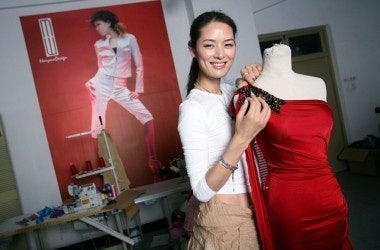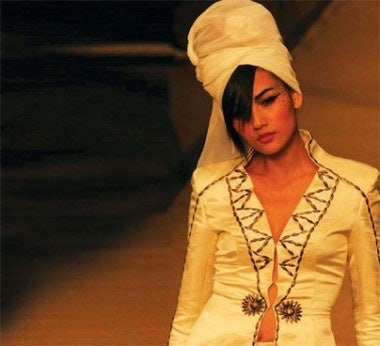Designer Mary Ma On Expressing Culture Through Fashion#

Chinese designer Mary Ma (Copyright Natalie Behring)
This week, as China Fashion Week runs in Beijing, Efu presents an interesting commentary by Chinese designer Mary Ma on fashion culture and how China fits in on a global level. The "East meets West" phenomenon has always been a popular trend among many domestic Chinese designers, but here, Mary Ma expresses why. Ma, a model in the late 90s who studied fashion design at Donghua University, has been hailed as China's first star designer.
From Efu (Translation by Jing Daily team):
We’ve long discussed clothing, discussed design, discussed trends, but it is simply a discussion of how to present ourselves more beautifully. We discuss because our hearts are pursuing beauty.
Sometimes, when we like a piece of clothing, or a brand, it is perhaps not because of its stunning design, or how it is perfectly cut. In more cases than not, the reason lies in ourselves, in other words, our self-confidence. This confidence comes from a sense of identity, how we identify with the brand and the brand culture. From a psychological perspective, self-confidence can strengthen or expand aesthetic appreciation and preferences. There’s that saying, “A confident woman is the most beautiful.” (Confidence is the most attractive quality.)
When you come in contact with something you do not understand, it may have a given quality or beauty that attracts you. You may develop a sense of curiosity and a desire to explore. The reaction to the unfamiliar qualities will be built up through the process of exploration. For clothing, there are usually two exploration channels: a brand’s promoted image, and a brand’s reputation. From these two points, passing through our own judgement, we’ll develop a general standard and expectation.
Following this path, we can think about the internationally popular big-name labels and look at our own perception of them. You might remember when and where you first heard the words Armani, Dior, or Chanel. You may not own anything from any of these brands, or even set foot in any of their boutiques, but this doesn’t prevent you from accepting that, “this is luxury, these are the best, these are worth having...”
Why? This is the power of culture. When a brand’s culture is able to infiltrate the hearts of the masses, it must be a successful brand. To do this is difficult.
Mary Ma's designs incorporate global motifs but maintain a Chinese backbone (Image: China Daily)
I usually divide fashion brand culture into two worlds. There's the "Old World," brands such as Burberry, a typical classic fashion label. I don’t mean that Burberry’s design is traditional, but that the brand has accumulated a cultural history. Then there's the "New World," like Alexander McQueen, the brand hasn’t been established for a long time, but based on its strong personal style, has quickly established relevance. Behind the two brands, we can also pinpoint a similarity -- England.
Undeniably, England’s traditional culture underlines Burberry, so much so that Burberry has become a standard of England. Even [the late] Alexander McQueen, who was influenced by British traditional culture and injected new blood into British tradition through the brand's rebellious expression. So I believe that culture of fashion lies in a country and nation’s culture.
When I started the brand
Maryma
, the purpose was very simple; I wanted to create my own brand, to wear what I thought was comfortable and beautiful clothing, and of course, I hoped that Maryma would be well-recognized. But later, a question that often occurred to me was why hasn’t China’s 5,000 years of cultural heritage been well-integrated into modern fashion?
On one of my trips to the United States, I went specifically to examine the American West cowboy fashion style, and I was inadvertantly exposed to Native American-style design. Locally, they described it as Navajo Prints because the Navajo is the largest branch of the American Indian tribes, and thereafter, the name was used for many other Indian-related products. While I see the clothing as simply exquisite and top of the line in wool textile technology, there’s a strange feeling, because I think in the assembly of various Indian elements, the inspiration becomes scattered, suspended in the air but not solidified. Perhaps the designer is not Indian, or perhaps they grabbed superficial elements without understanding the essence of Indian culture.
When I think of the Chinese style that is popular globally -- painting, porcelain, Peking Opera makeup, Chinese knots -- I can’t say that there’s anything wrong with those clothes, they’re very beautiful, and the use of the elements is very clever. But you should know that in a crowd of many beautiful girls, the ones who are most cultured and well-disposed are the ones who get people’s attention. Clothing is the same, with the foundations being temperament, meaning, and culture. That is also why Castiglione’s painting could be similar [to Chinese], but could not reach a higher level. [Ed. note: Castiglione refers to Giuseppe Castiglione, who was an Italian Jesuit missionary in China and a Qing court painter in the 1700s.]
Gianni Versace said something that made a deep impression on me: “It was a bold and elegant Italy that created Versace.” When talking about modern fashion, the first thoughts are Italy and France. There are some keywords you naturally connect to these countries or cities, unrestrained - Italy, romantic - France, free - the United States, precise - Germany, gentlemanly - England...and now, we have no choice but to examine ourselves and ask ourselves what characterizes China? Actually, for a while now, some of my fellow designers and I have been considering these questions. Do our modern designs embody the characteristics of our culture? Is it just stopping at "similar"?
When we make clothes, we’re making culture. Clothing is the carrier, while design is the method, the language. What it carries is culture, insight into Chinese cultural heritage. Locating and grasping the essence of Chinese culture, placing Chinese culture on an international platform, this has always been Maryma's and my unrelenting goal and motivation. Identifying and grasping the essence of Chinese culture, integrating heritage with new technology and craft, designing clothing for the modern Chinese. Perhaps we can describe this type of clothing as “costume.” Not necessarily resplendent, but certainly China.
As a Chinese fashion designer, I hope to bring real Chinese culture to the world, for all the people in the world to appreciate and understand.
